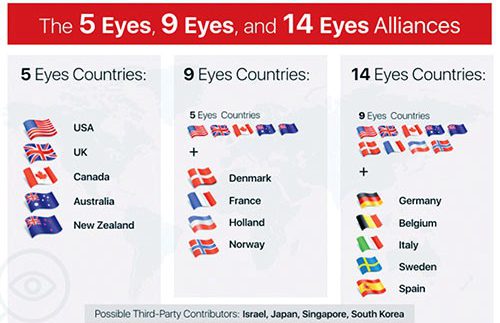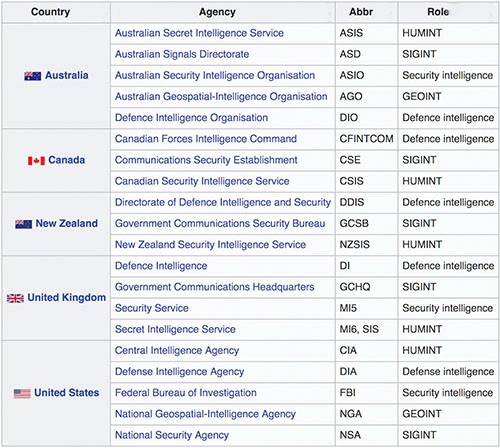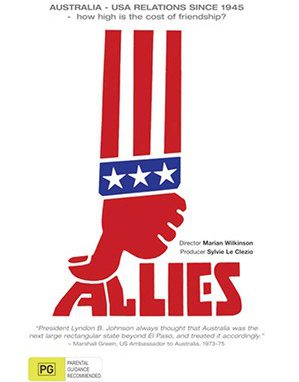Five Eyes: the international syndicate that spies on the entire world (1)
Power is a peculiar aspect. In different ways, we’ve become accustomed to co-existing with it and will even forgo some liberties as part of a Faustian trade-off for various modern conveniences. When that power is virtually invisible, it is beyond scrutiny; and when it’s transnational, it takes on a whole new dimension.

We are now fast approaching a point in history where opaque structures of power pose a direct threat to our hard-fought-for constitutional and democratic institutions. Former US National Security Agency (NSA) and Central Intelligence Agency (CIA) analyst turned whistleblower Edward Snowden offered the general public their first real glimpse of this new reality, back in 2013, when he leaked the largest single classified document dump in history.
He revealed what could only be described as a vast international conspiracy, in which multiple Western intelligence agencies work hand-in-hand collecting and analysing the personal data of their citizens, completely side-skirting any domestic laws guarding our right to privacy and due process.
This ‘conspiracy’ plays a pivotal role in backing-up various allied deep states around the world. The operational core of this digital syndicate is known as the Five Eyes alliance. Code named “FVEY”, it represents an international signals intelligence (SIGINT) and communications intelligence (COMINT) gathering agreement between the United States, United Kingdom (UK), Canada, Australia and New Zealand.
The Five Eyes alliance agencies include, but are not limited to, the US’s NSA and CIA, the UK’s Government Communications Headquarters (GCHQ), Canada’s Communications Security Establishment Canada (CSEC), the Australian Signals Directorate (ASD), and New Zealand’s Government Communications Security Bureau (GCSB).
This cooperative intelligence-sharing arrangement traces its historical roots to the UK-USA Agreement of 1946, as generally agreed in the 1941 Atlantic Treaty signed between the Allied powers during World War Two. After its official status was announced in 1955, the Five Eyes was expanded to the Nine Eyes, which includes the original five members along with four additional partnering governments who are granted “third party status.” These include spying agencies from Denmark, France, the Netherlands, and Norway.
The Nine Eyes would later expand to a Fourteen Eyes agreement which includes the Nine Eyes plus Germany, Belgium, Italy, Spain, and Sweden. Not surprisingly, the Fourteen Eyes more or less corresponds with the core European members in the NATO military alliance.
The Fourteen Eyes may also be extended up to 17 Eyes when considering other regular third party contributors like Japan, Singapore, and Israel.

In the late 1960s, the Five Eyes launched the ECHELON program, powered by a global array of US-run satellites and SIGINT bases located in North America, Europe, Asia, and Australia.
Initially, the Five Eyes arrangement was ideally suited for the Cold War where the primary task was gathering intelligence from the former Soviet bloc countries and their allies.
Later, as the internet expanded, the sheer volume of digital content and communications meant that the Five Eyes had to readjust its core competency – from an organisation mainly preoccupied with spying on governments, institutions, and persons of interest, to an organisation whose primary task was to spy on absolutely everyone.
With this new raison d’être in conscience, the Five Eyes cooperative framework became ideal for allowing spy agencies to bypass domestic laws that might prohibit them from conducting surveillance or hacking their country’s own citizens. Overcoming legal or technical barriers became fairly straightforward, especially in the wake of the attacks of 9/11.
The USA Patriot Act meant that intelligence and law enforcement agencies could invoke national security and require telecoms companies and internet service providers (ISPs) to allow fibre optic splitters to be installed at key nodes in the telecommunications infrastructure, allowing spooks to divert massive data flows to be captured and run through the various Five Eyes data analysis centres.

The digital revolution gave the Five Eyes syndicate the ability to amalgamate and combine what was previously separate disciplines of intelligence – like SIGINT, COMINT, geospatial and human intelligence – now all rolled into one comprehensive data collection system. Once they reached this stage, getting it to perform was simply a case of tweaking the software.
When Snowden’s story broke in 2013, one of the key components of the NSA’s mass surveillance operation was a software interface called XKEYSCORE. The Intercept describes the tool as follows:
“The sheer quantity of communications that XKEYSCORE processes, filters and queries is stunning.
Around the world, when a person gets online to do anything – write an email, post to a social network, browse the web or play a video game – there’s a decent chance that the internet traffic her device sends and receives is getting collected and processed by one of XKEYSCORE’s hundreds of servers scattered across the globe.”
Whereas previous iterations of the NSA’s global information dragnet hauled in large quantities of data and required a combination of computer and human intelligence to sift through it all, XKEYSCORE “extracts and tags metadata and content from the raw data so that analysts can easily search it,” allowing for a much more refined and efficient data capture operation.
In essence, what used to be done by the entire ECHELON system and scores of human analysts could now be achieved with a few strokes of the keyboard.
“Spectre” is real
Michael McKinley of the Australian National University, in an article describing the full scope of the NSA’s digital arsenal, mentions “[t]he known codewords for them over recent times:
Blarney, Echelon, Dancingoasis, PRISM, Tempora, XKEYSCORE [sic], Muscular, Pinwale, EgotisticalGiraffe, Stormbrew, Fairview, Oakstar, Mainway, Rampart-T, and Nucleon.
Between them, they aim to attack computers using certain types of legal privacy software, and overall to harvest, store, and analyse whatever internet traffic can be hoovered up.”
Imagine if the NSA connected all of these data trawling nodes with an artificial intelligence backbone that analysed and parsed out teraflops of information in real-time. It would make the agency omnipotent. This very same dystopian scene was brought to life on the big screen in the 2015 James Bond film “Spectre” starring Daniel Craig.
In the film, a latter-day Blofeld, played by actor Christoph Waltz, devised a new unofficial international ruling committee, S.P.E.C.T.R.E. (Special Executive for Counter-intelligence, Terrorism, Revenge and Extortion), comprised of the world’s top organised crime figures. Through his network’s infiltration of the very top levels of Western intelligence, Blofeld receives unrestricted, real-time access to all surveillance data collected by the “Nine Eyes” countries. This backdoor key gives Blofeld the power to steer global political events, move markets, and when necessary, blackmail any person or institution into compliance.
Aside from its striking parallel to the West’s current global surveillance dragnet, “Spectre” raises important questions obscured by the film’s ostentatious plot. Even without Blofeld, the current Nine Eyes intergovernmental network retains all of the capabilities that any nefarious villain would ever want, to wield power or ward off any potential challengers. If operations are conducted outside public view, then the potential for abuse is virtually boundless.
Five Eyes: A Fraternal Order
The fraternal nature of SPECTRE was alluded to by the antagonist’s cinematic forefather, Ernst Stavro Blofeld, depicted in the 1963 Bond film “Thunderball”.
“SPECTRE is a dedicated fraternity whose strength lies in the absolute integrity of its members,” said Bond’s nemesis.
Blofeld wasn’t wrong. In essence, the Five Eyes intelligence network is precisely that – a type of Anglo-fraternal organisation that wields a noticeable advantage over its rivals. Such unfettered cooperation between advanced nations like the US, UK, Canada, Australia and New Zealand, means that the technical continuity of this geopolitical alliance remains more or less unmatched.

Leveraging the resources of five countries spread around the globe affords the coalition a substantive advantage over just about any other global competitor. No other bloc can match its scope and scale, geographically and technologically.
It is also fundamentally neo-colonial in nature. The fact that this network comprises current and former British colonial possessions speaks to the Anglo-centric or Atlanticist worldview on which its mission is based.
That Atlanticist agenda is best described as something akin to a Bilderberg Committee agenda – a set of political and industrial objectives and goals informally agreed upon by some of Western society’s most powerful luminaries and technocrats who meet at the beginning of summer at the annual Bilderberg Meeting.
Interestingly, this fraternal brotherhood only seems to extend to certain allies. While German spy agencies like the Bundesnachrichtendienst (BND) cooperate with their US counterparts as a “third party” government through the Fourteen Eyes agreement, Washington spooks still feel the need to constantly spy on Berlin.
The 2013 Snowden leaks revealed that Germany is a major target of US espionage run out of the NSA’s own European Cryptologic Center (ECC), known affectionately as the “Dagger Complex,” located in Griesheim, in the German state of Hesse. According to “secret” NSA documents viewed by the German publication Der Spiegel, the American bunker accounts for the agency’s “largest analysis and productivity in Europe.”
The documents also note that the NSA uses its infamous XKEYSCORE software to trawl up its main areas of interest from inside the German government, namely foreign policy, economic stability, new technologies, advanced weaponry, arms exports, and international trade.
To add insult to injury, WikiLeaks revealed in 2015 that the phone of German Chancellor Angela Merkel had been wiretapped for years by US spies. When interviewed on the matter, former NSA and CIA head Michael Hayden was quite flippant, openly admitting, “We steal secrets. We’re number one in it…. But, he adds, this is not malicious or industrial espionage…. We steal stuff to make you safe, not to make you rich.”
Hayden lamented the German disclosure but admitted the US government had grossly underestimated German values on issues pertaining to privacy, stating:
“Perhaps we underestimated the depth of feelings that the German people – and again, not just the chancellor, but the German people, felt about this question of privacy, given their historical circumstances compared to our historical circumstances.”
At the Munich Security Conference it was clear to many that Germans regard privacy the way Americans might regard freedom of speech or religion. In similar fashion, both the European Union and the United Nations are also said to be under US surveillance.
Like with Germany, NSA espionage objectives on the EU include foreign policy goals, the economy, international trade, and “energy security.” The targeting of the UN adds a whole other international dimension to these operations. A 2013 report filed by The Guardian newspaper paints a rather disturbing picture:
“[L]ong before [former United Nations Secretary-General] Ban’s limousine had even passed through the White House gates for the meeting, the US government knew what the secretary general was going to talk about, courtesy of the world’s biggest eavesdropping organisation, the National Security Agency.”
Australia: casualty in a cold war
On the surface, having the NSA conduct surveillance operations on key allies like Germany may not make much sense. Why would America risk compromising an important relationship with a pivotal partner and fellow NATO member? To help answer that question, we need to go back 50 years and look at what occurred in Australia circa 1970:

In the groundbreaking documentary film “Allies” (1983), a number of top former US and Australian politicians and intelligence officials went on camera to recount one of the most tumultuous periods in the country’s history during the Cold War, marked by the establishment of the Australian Security Intelligence Organisation (ASIO). The film disclosed a series of shocking admissions rarely heard before in public, but which lifted the veil on the hidden hierarchy latent within the Five Eyes order. Revelations included an admission by Victor Marchetti, former executive assistant to the deputy director of the CIA (1955-1969), who stated: “Intelligence organisations in many countries have a loyalty that is not necessarily to the duly constituted government, they have a loyalty to what they consider the establishment.” Some officials testified that their loyalty was not to their elected leaders but the CIA.
Such testimony provides some of the most unequivocal evidence to date about the existence of an unelected shadow government or Deep State, directed by America’s Central Intelligence Agency. For the Americans, managing this autonomous power structure first meant securing its geostrategic interests in host countries as well as its strategic facilities like the NSA’s Pine Gap listening base located in central Australia. Securing these assets became a national security issue – Washington could not risk any newly elected government interfering with US intelligence operations.
In the film, Dr John Burton, Secretary of the Australian government Department of External Affairs (1947-1950), described the Five Eyes thinking as follows:
“…the need for an intelligence organisation was to ensure that governments elected (for example) on a social welfare platform would not argue that they had a mandate to recognise China, to change the agreement with the United States, or other things which the Labor Party had intended before the Petrov Commission.
They’ve always argued that the intelligence operation, or the intelligence services, operating as an informal group – are the protection of democracy against itself.”
While the notorious Petrov Affair (1954) helped sideline Australia’s Labor party for many years afterwards, the real trigger for a US-backed coup came in 1972 when Gough Whitlam led Labor to victory for the first time in 23 years. The Whitlam government called into question Australia’s supporting roles in various military conflicts taking place in Southeast Asia, including Vietnam and Indonesia, and challenged the top-secret nature of US bases operating in Australia.
Details of a CIA plot to depose Whitlam were revealed by NSA contractor Christopher Boyce, who was convicted of espionage and sentenced to federal prison in the US. Boyce’s story was later made into a cinematic classic, “The Falcon and the Snowman”. Whitlam would soon be removed from office in 1975 after being “dismissed” by the country’s Governor-General, with much of the evidence pointing to a US/British regime-change operation.
This marked a noticeable shift to the right in Australian politics and an unflinching “special relationship” with subsequent US Administrations. This story demonstrates the lengths that the US-led Five Eyes syndicate is willing to go to secure its assets in foreign countries. In the case of Australia, this meant US intervention to derail any government that might threaten US foreign policy and its global intelligence operations.
From this vignette, one could draw a parallel to Washington’s ill-treatment of Germany – another ally that also hosts numerous US military bases and intelligence-gathering facilities, and which functions as an anchor for US operations in Europe in much the same way Australia does for the Asia-Pacific region.
Read the second part of the article
yogaesoteric
November 8, 2022
